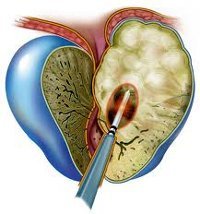Acute prostatitis – infectious diseases-the defeat of the prostate gland, accompanied by swelling and the formation of purulent foci in the prostate tissues. The acute manifestation of prostatitis depend on the initial phase (bluetongue, follicular, parenchymal, abscessed), and may include dysuria disorder, perineal pain, fever, intoxicating. The diagnosis is based on data palpation of the prostate, ULTRASOUND and Doppler studium of the prostate, research-detachable urethra and the secret of the prostate. The treatment of prostatitis includes the appointment of antimicrobial therapy, NSAIDS, anti-spasmodics, analgesics, immunomodulators, and physiotherapy.

Acute and chronic prostatitis are the most common and socially significant male disease. In the urology clinic prostatitis diagnosed 30-58% of men are in the reproductive and working age (30-50 years). For acute prostatitis is accompanied by disorders of sexual function and fertility disorders, emotional state and social disadaptation.
Causes of acute prostatitis
Pathogens of acute prostatitis mainly act non-specific infectious agents, penetrating into the tissue of the prostate - gram-negative (escherichia coli, klebsiella, proteus) or gram-positive (staphylococci, enterococci, streptococci)
Often acute prostatitis can be caused by pathogens urogenital infections:
- chlamydia,
- trichomoniasis,
- ureaplasmosis,
- gonorrhea,
- mycoplasmosis,
- candidiasis, etc.
The more often the penetration of microbial agents in the tissue of the prostate occurs transcanalicular through ducts excretory gland that open into the posterior wall of the urethra. Then urethritis of any origin is very often complicated acute prostatitis in the act. Less microbial flora enters the prostate from the bladder during acute cystitis. The introduction of pathogens in the gland greatly facilitated by the increase in intraurethral pressure (reprehenderat, stones urethra), the performance of the endourethral manipulation (bougienage urethral catheterization of the bladder, ureteroscopy, cystoscopy, etc.).
Additionally, acute prostatitis may be the result of hematogenous infections, which contribute terms of inflow of blood to the prostate gland with a well developed system of arterial and venous anastomosis. When hematogenous drift of germs can penetrate in the tissue of the prostate from distant purulent foci when tonsillitis, sinusitis, caries, cholecystitis, bronchitis, pyoderma, etc. Perhaps lymphogenous infection of the prostate from the bowel when anal fissures, proctitis, and colitis.

For non-communicable factors, contributes to the development of acute prostatitis refer to persistent stagnation in the veins of the pelvis and the violation of the drainage acini of the prostate. Stasis can be called disritmia sexual life and sexual disorders – practice interrupted intercourse, lack of or irregular sexual life, excessive sexual activity, etc., the Pathological storage of blood in venous pelvic can be celebrated with a sedentary lifestyle, frequent constipation, subcooling, chronic (especially alcohol) intoxication, varicose veins of the veins of the pelvis.
Form of acute prostatitis
Developing acute prostatitis distinguish the following forms, which are also the stages of:
- catarrhal,
- follicular,
- parenchymal,
- abscesses.
Acute prostatitis begins with inflammation, catarrhal – changes in secretion of the mucosal and submucosal layer of the excretory ducts of the individual slices of the breast. Later edema of the walls of the ducts and promotes the accumulation of muco-purulent secret in the follicles of the prostate and the progression of inflammation, in relation to which it can develop patches of suppuration lobules – follicular acute prostatitis. The plural defeat of the lobules, and diffuse involvement, parenchymal and interstitial tissue of the prostate gland purulent inflammation, acute prostatitis is entering its next phase – parenchymal. In the case of a merger of small ulcers in a large home formed an abscess of the prostate gland, which can be opened into the urethra, the vagina, the rectum or the bladder.
The symptoms of acute prostatitis
The clinical manifestations of acute prostatitis correspond to the stages of the process. Common manifestations serve pain, disorders of urination and intoxication.
Acute bluetongue stage of prostatitis and feels the heaviness and pain in the perineum. Dysuria disorder characterized painful frequent urination, especially at night. The body temperature is maintained in the standard, maybe slightly higher; intoxication missing. When palpation examination of the prostate is not changed or slightly increased, more painful. The search for the secret of the prostate gland detects the increase of the white blood cells, the accumulation of muco-purulent wires. In the urine during the emptying excretory ducts acini appear to be leukocytes. Massage of the prostate, usually, it is not possible because of the pain. The treatment, developed in the bluetongue disease, the acute phase of prostatitis, leads to healing 7-10 days.
The follicular form of acute prostatitis and flows more brilliant, and accompanied by the stupid aching pain in the perineum, irradiating in the penis, anus, or the sacrum. In this context, urination is difficult and painful, until the development of acute urinary retention. The act of defecation acute follicular prostatitis is also difficult because of the expressed pain. As A result of increased body temperature of 38°c is broken, the general condition. Palpable for the angles of the determined increased, dense, intense, the prostate asymmetrical, dramatically painful in some sections to reflect research. The Urine collected after the palpation of the breast, in a large number of leukocytes and purulent wires that form the sediment of muddy. Possess a massage to get the secret of the prostate gland in the follicular phase of acute prostatitis is contraindicated. In the case of abrupt treatment follicular acute prostatitis can be resolved favorably; if not, it moves on to the next, the parenchymal phase.

Clinical acute parenchymatous prostatitis is developing rapidly. It is characterized by severe hyperthermia (39-39,5°C and above) with chills, general weakness, suppression of appetite, thirst. The first urination drastically learning and hampered, and then may cease entirely. The attempts of emptying of the bladder or of the intestine are accompanied by intense pain. Develop excruciating tenesmus, constipation, flatulence. The pain extends to the right, wearing a button nature, forces the patient to take stimulated the lying position pre-loaded with the walk. With the development of the jet inflammation of the rectum from the anus stands out mucus.
Palpable determined diffusely increased, by the indistinct contours of iron, which is extremely painful to the slightest touch. Prostate massage in the parenchymal phase of acute prostatitis is contraindicated, categorically. Sometimes because of a strong edema pararectal fiber, and rectal pain review spend impossible. In the urine clearly expressed album sanguinem cellam, pyuria. The result of acute parenchymatous prostatitis may serve resolution of the disease, the formation of an abscess of the prostate or chronic prostatitis.
The diagnosis of prostatitis
The recognition and definition of the acute prostatitis develops urologist, and is based on a complex physical examination, laboratory and tool examination. Research of carcinoma of the prostate through the rectum to determine the size, consistency, homogeneity, symmetry of the breast; the pain and the reaction, pockets of decay, signs of fusion of the tissues. Palpation of the breast of acute prostatitis is performed with great attention without a big boost and massaging movements. The secret message of the prostate is detected an increase in the number of white blood cells and amyloid taurus, the reduction in the number of granules of lecithin grains.
Acute prostatitis observed a greater leucocyturia in the third portion of urine and urine collected after the palpation of the prostate. To highlight pathogen acute prostatitis need to do bacterial inoculation test urine and detachable urethra with antibiotics, PCR-research scraping, planting blood on sanguinem culture. The nature and severity dysuric disorders acute prostatitis is estimated using uroflowmetries.

ULTRASOUND of the prostatic with a moderate pain syndrome can be transrectal; in the case of express the reaction of the pain – transabdominal. Anoscopically estimated the shape, the size of the breast, the presence of focal or diffuse changes, is the acute phase of prostatitis. The use of Doppler studium allows you to details and in a different way to evaluate the vascularity of the prostate.
During the planning of surgical tactics destructive in respect of the forms of acute prostatitis, it is advisable to conduct a CT scan or a magnetic RESONANCE imaging pelvic.
The treatment of prostatitis
The role of a guide in the treatment of prostatitis belongs to the causal therapy. You must, as soon as the appointment of antimicrobials (antibiotics, antiviral drugs, antitrichomonal, antimycotic) drugs to inhibit the reproduction of microorganisms in iron and tissue of the urethra. With the aim of reducing spasms and pain on urination will prescribe painkillers, anti-spasmodics, rectal candles with Anaesthesinum or belladonna, and the heat double. In the complex therapy of acute prostatitis used NSAIDS, enzymes, immunomodulators, vitamins, infusion of solutions.
Physiotherapy acute prostatitis occurs after replacing the acute symptoms. With the goal of anti-inflammatory, decongestant, pain reliever actions to improve the microcirculation, local immunity apply rectal electrophoresis, UHF-therapy, MICROWAVE therapy, massage of the prostate. Acute prostatitis shown the respect to rest in bed, diet, peace.
In the event of a delay of urine on the background of acute prostatitis avoid bladder catheterization, giving preference trocar cystostomy. When abscess of the prostate occurs the need for surgical aids opening and drainage of the cavity of the abscess.
Of care acute prostatitis judged for the recovery of the structure of the tissues of the glands and its functions, the normalization of the composition of the juice of the prostate, elimination of pathogens that cause inflammation, and of biological fluids.
Prediction and prevention
Usually, punctual and reasonable causal therapy leads to cupping, signs of acute prostatitis. The formation of abscesses in the prostate or chronic inflammation occurs in advanced cases.
Prevention of acute prostatitis should include the reorganization of the outbreak of infectious diseases in the body, in the possession of endovesical and endourethral manipulations in accordance with the rules of asepsis, the timely treatment of venereal disease, and urethritis, the normalization of the sexual life and physical activity.

























